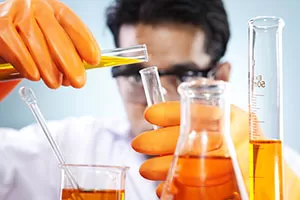Resins and Curing Agents: Formulating Epoxy Systems
When developing a one component UV or heat curable, or two component room temperature/heat curing epoxy system, formulators need to access the properties conferred upon the system by the resin system. For the resin which is usually designated as Part A in a two component epoxy system or is used as is in a one component UV/heat curable epoxy system, there are a few choices:
- Bisphenol F resin
- Bisphenol A resin
- Hydrogenated Bis A resin
- Novolac resin
- Cycloaliphatic epoxy resin
- Multifunctional resin

| Resin Type | Temperature Resistance | Cure Type | Product | System Type | Key Product Highlight |
|---|---|---|---|---|---|
| Bisphenol F resin | Fair | Room/heat | EP62-1BF | 2 part | Excellent chemical resistance |
| Bisphenol A resin | Good | Room/heat | EP93FRHT | 2 part | Good dielectric properties |
| Hydorgenated Bisphenol A resin | Good | Room/heat | EP21LSCL-2 | 2 part | Good non-yellowing profile |
| Novolac | Very good | Room/heat | EP41S-5 | 2 part | Excellent chemical resistance |
| Cycloaliphatic epoxy resin | Excellent | UV/heat | UV22DC80-1 | 1 part | Good dimensional stability |
| Multifunctional resin | Outstanding | Heat | EP46HT-1 | 2 part | Very high Tg |
In some formulations, these resins can be used on their own or in combination with other resins to formulate the optimal epoxy system.
Curing Agents
For choosing curing agents, there are a few options to consider while formulating an epoxy system, which can help in attaining the desired properties in a wide range of applications. Here are some of the options:
- Aliphatic amines
- Polyamides
- Cycloaliphatic amines
- Aromatic amines
- Anhydrides
- Imidazoles
- Lewis acids
| Curing Agent Type | Temperature Resistance | Cure Type | Product | System Type | Key Product Highlight |
|---|---|---|---|---|---|
| Aliphatic amines | Very good | Room/heat | EP30-2 | 2 part | Very low outgassing levels |
| Polyamides | Good | Room/heat | EP21LVMed | 2 part | Excellent dielectric properties |
| Cycloaliphatic amines | Excellent | Room/heat | EP39-2 | 2 part | Very good chemical resistance |
| Aromatic amines | Excellent | Heat | EP45HTAN | 2 part | Excellent chemical resistance |
| Anhydrides | Excellent | Heat | EP110F8-1 | 2 part | Excellent dielectric properties |
| Imidazoles | Very good | Moderate heat | EP62-1LO | 2 part | Excellent chemical resistance |
| Lewis acids | Very good | Room/heat | EP19HT | 1 part | Fast cures |
Once again, while formulating epoxy systems, it must be kept in mind, that these curing agents can be used in combination in certain formulations to provide the desired results.
Master Bond Epoxy Novolac Based Resin Compounds
Employed in both single resin and mult-resin formulations Novolac based resin compounds offer enhanced thermal stability, chemical resistance, bond strength in comparison to conventional resin systems. Heat cure will improve the cross link density and performance properties of these products depending on the length of the elevated temperature cure. These resin systems are noted for simple easy handling/processing, good storage stability, long term durability/strength retention, ability to withstand chemical attack/solvent exposure. They also feature high Tg, outstanding electrical properties in wet/heat environments. Epoxy novolac based resin products are frequently cured with conventional curing agents. From tank linings to electrical encapsulation to prepegs to structural adhesives to filament winding epoxy novolac resin systems provide batch to batch consistency. Some Master Bond products using this resin are:
Anhydrides
Curing agents used in numerous impregnation, potting, encapsulation and casting applications. Offer outstanding electrical insulation, long pot life, excellent mechanical strength and high temperature resistance. Formulations range from optically clear systems to low exothermic compositions to high Tg and low cure shrinkage. They have many advantages over amine cured epoxies and are employed in filament winding, pultrusion processes for fiber reinforced composites. Wetting and adhesive characteristics are noteworthy.
Master Bond has a few products using this curing agent class. Some examples include:
They require heat curing and extensive post curing helps enhance their cured profile.
